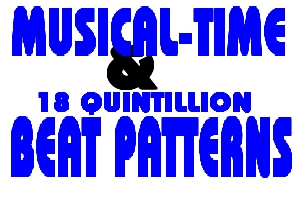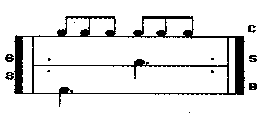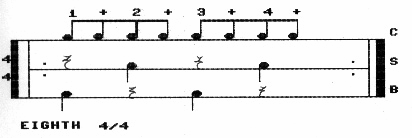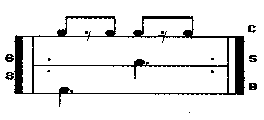|
Bill Powelson's,
MUSICAL TIME & RHYTHMS:

"FINITE TO INFINITY"
Understanding
Time-Signatures and Beat Permutations.
The Basic Dance Beats

NOTE: This info is for those who do not know it already. You'll need all this
in order to visualize and see the big-picture in the later lessons. Though we are focusing
on drumming techniques here . . . these same beat patterns may occur as arpeggios and/or relative
background rhythms on instruments other than drums.
~~~ ~~~
The bulk of modern music is based on these few simple beat patterns. Learn these beats and play any
song. Playing with music will come NATURAL, and you will be playing by 'ear' once you have mastered
these rhythms. AS A BONUS, you'll be learning to read
DRUMMING-NOTATION TOO. This is the absolute, easiest possible way to learn to read and understand all
musical rhythm.
THE SECRET!
First memorize each of the following beats to a point where you can repeat
them rapidly. Then, turn on a radio, or put on a favorite CD.
Listen deeply into the
background of whatever song may be playing, and try to 'feel' the basic beat pattern
that is being used within the song. No matter what song you are hearing, it
will be based on one of the following 5 beats, 97% of the time . . .
SIMPLE, EASY STEPS . . .
- Memorize all 5 basic beat.
- Categorize each song into one of the 5 beat categories.
- Feel the basic beat pattern of the song.
- Begin playing along in-time with the beat of the music.
As you study and learn these beats, notice that
a mathematical pattern becomes evident between the speed or tempo of the beat, and the number
of cymbal (hi-hat) notes being played. Slow songs require more fill notes on the cymbal and
fast songs require less.
No matter what style of music you listen to, you'll be playing along, the very
next time you turn on your radio, or listen to your favorite CDs, once you've memorized
the following 5 beats.
IMPORTANT TIP!
Simply repeat the beats 'as if' you were on a real drumset. Pound on the desk or anything
near-by, and pat your right-foot on the floor for the bass-drum. Repeat each pattern
until it flows naturally, without thinking.
Practice them during your idle moments,
wherever you are, as you go through your day.
Shortly after that, no matter what songs play on the radio, you will discover that
you can listen for the drums, then join in, and play along . . . almost like magic. When that
begins to occur (and it will), proceed with the other lessons.
MEMORIZE THESE FIVE BEAT PATTERNS!
Dance beat #1:
16th 'SLOW ROCK' 4/4
Approximately 15 songs per 100 will utilize some form of this basic beat.

 Hear the Basic 16th ROCK Beat Hear the Basic 16th ROCK Beat
CAN YOU READ THE ABOVE BEAT?
I am assuming that you can read and understand these patterns. If you find the above beat pattern confusing,
then take 5-minutes, and learn to READ DRUM NOTATION. Go over that lesson
until you understand it, then return.
HINT: On top of the 16th rock example you will see the counting procedure. It often helps to say the
actual words "one, ee, and, aah, two, ee, and, aah", and so on. You will be saying "and" with each "+" that you see.
Pat your foot as you say "one" and tap your left hand as you say "two". Follow through and keep it going.
Try this! If it helps, use it.
Dance beat #2: 6/8 'BLUES'
Approximately 12 songs per 100 will utilize some form of this basic beat.
COUNT: 1 2 3 4 5 6

 Hear the Basic BLUES Beat Hear the Basic BLUES Beat
Writing conventions dictate that most of these patterns may be written several ways. For example,
the above pattern could be written as 'Triplet 2/4' or even 'Triplet 4/4'. Don't let that
issue confuse you. The beat will sound the same, no matter how it is written. It'll all be explained
in minute detail, as we study the upcoming lessons. The main thing
right now is to learn to play it, and recognize it, as it occurs within the music you'll hear around
you every day.
Dance beat #3: Eighth 'ROCK' 4/4
Approximately 45 songs per 100 will utilize some form of this basic beat.

 Hear the Basic ROCK Beat Hear the Basic ROCK Beat
We studied this beat in the previous lesson because it is the most often used. It is
included again here so that you can see how it falls into the tempo scale of primary dance beats.
This is a medium tempo beat. Remember! Faster tempos (speeds) require less notes on the cymbal and slower
tempos require less.
Dance beat #4: 6/8 'SWING/SHUFFLE'
Approximately 20 songs per 100 will utilize some form of this basic beat.

 Hear the Basic SHUFFLE Beat Hear the Basic SHUFFLE Beat
Notice the eighth rests on the cymbal line. Think in groups of three but omit the middle cymbal of each group. . . (what a nightmare). Listen to the sound file for a long time and try to play along with it.
Move ahead if you are having problems. It will seem much easier after you have been playing a while longer.
NOTE: These patterns may be written many various ways. Only the most simple forms are being shown here.
Dance beat #5: Quarter note 4/4 or 'QUARTER ROCK'
Approximately 5 songs per 100 will utilize some form of this basic beat.

 Hear the Basic 4th Rock Beat Hear the Basic 4th Rock Beat
This is a dance beat with many nicknames. It may be called Quarter rock, Doubletime, Cut time, Jazz,
Breakdown, Uptempo, Quicktime, Polka or others that I haven't mentioned. If a song is fast . . . really fast,
then this is the beat to use.
NEXT LESSON . . .
Understanding Note-Values and Rhythm Terms: * This is basic knowledge. Many
of you may already know these things. Scan it quickly to be sure. Linger and study,
if you have doubts. This knowledge is VERY important towards understanding the bigger picture to come,
in the later lessons.

Copyright Bill Powelson
1985-2xxx all rights
reserved.
|



 Hear the Basic 16th ROCK Beat
Hear the Basic 16th ROCK Beat 


